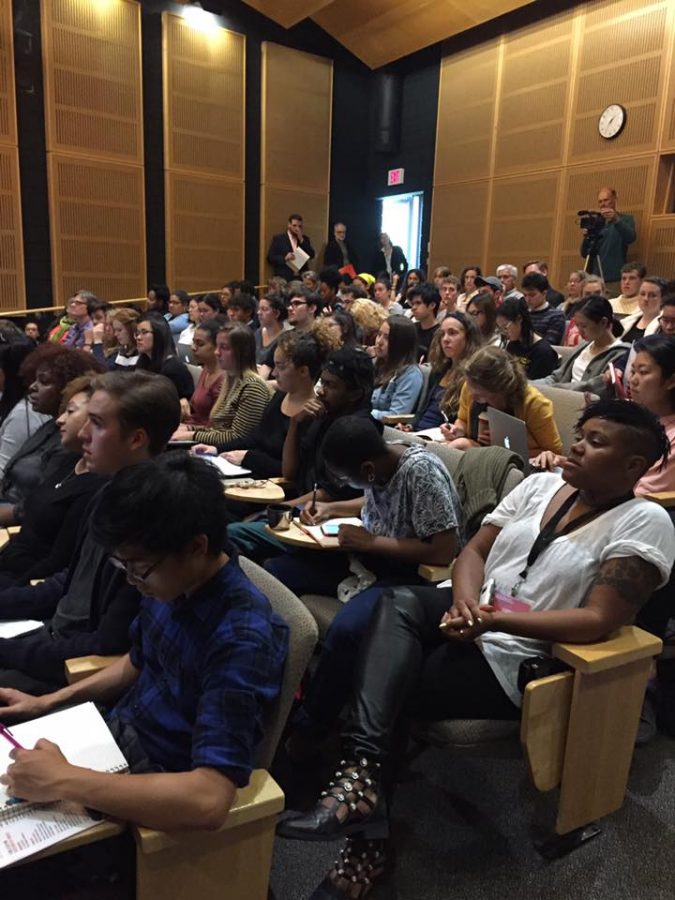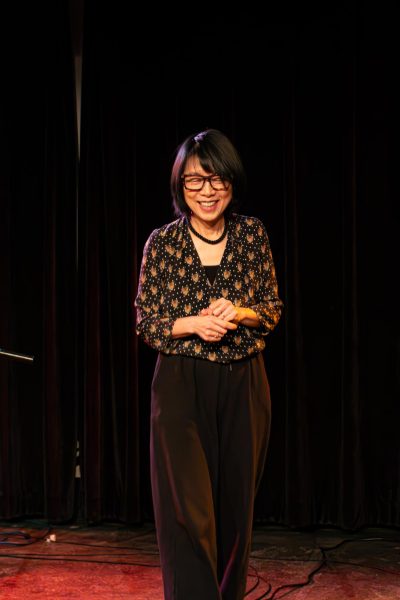Conference Addresses Intersections of Race, Aesthetics
Photo courtesy of Charles Peterson
Conferencegoers attend the second day of panel presentations on race, art, and aesthetics last Saturday.
“Exploring Beauty and Truth in World of Color,” a conference which took place over last Friday and Saturday, highlighted new and groundbreaking work on the subject of race and aesthetics from Oberlin academics and scholars from many other institutions. The two-day conference, which had wide community appeal, explored essential conversations about the role of Blackness and Black aesthetics in diverse art forms.
For Associate Professor of Africana Studies Charles Peterson, the driving organizing force behind this conference, a major point of focus was the interdisciplinary nature of aesthetics as an academic field.
“[Scholarship that crosses disciplines] can have a very vibrant intellectual life,” he said. “Speaking across disciplines can be fruitful and generate tremendous new ideas and perspectives. For those who are caught in rigid disciplinary perspectives — do not be afraid of moving across the divide.”
The conference included panel sessions on fashion, technology, afro-futurism, humor, film, visual art, music, theater, and curriculum and pedagogy, as well as a student panel. The keynote speech, “We Have Voice, We Have Temper: African American Artists and Public Discourse,” was delivered by Kymberly Pinder of the University of New Mexico.
The seventh presentation of the conference, conducted by speaker Chris Jenkins, focused on the application of Black aesthetics to African-American music. Jenkins posed the idea that Black speech uses “signifyin(g)” — a literary device that “turns” the literal meaning of words into a metaphorical meaning — to appeal to a select “in” group which identifies with that reference exclusively. He cited examples like “yo’ mama” jokes and how Michael Jackson and countless others have used the word “bad” to mean “good,” analyzing how these coded phrases have entered mainstream conversational speech. Phrases like, “shake it like a polaroid picture” or “drop it like it’s hot,” for instance, can’t really be explained in a literal sense, but if you’re a member of the “in” group, you know what they mean. In a more technical musical sense, Jenkins also referenced compositional techniques such as the pentatonic scale, which uses five notes in repetition as well as syncopation, which can be used to create a rhythm that mimics a theme or motif.
Following Jenkins’ presentation, the eighth session featured Associate Professor of Theater and Africana Studies Justin Emeka, OC ’95, whose presentation was titled “Playing with Race: Casting Black and Brown Bodies in White Classical Theater.” Professor Emeka spoke of the struggles that actors of color face when auditioning for classical theater. He suggested that even modern productions of white classical theater continue to mold the actor of color into a white skin for the role, rather than changing the role itself. They do this, he said, because audiences don’t empathize with non-white representations of characters on stage.
“As an actor and a director, I’ve found three ways to approach casting a Black actor for a role that’s written for a white actor,” Emeka said. “You can approach it like you’re creating a colorblind society where race does not exist in the world of the play you’re creating, or you can approach it as, you know, this actor, this Black or Brown actor is playing a white character. And the character is still white, and theater is make-believe — anybody can play anything. You can have a grown man play a kid, you can play an animal. Or, you could change the role of the character to match the role of the actor … Now this character is a Black character in this world — and let’s see what happens to the play.”
Though delayed by about half an hour, the Student Panel presentation that followed the eighth session was not one to miss. The main portion of the panel showcased College junior Kennedy Kline and Conservatory senior Theodora Nestorova’s readings of analytic papers they wrote for the Philosophy of Music course, which might not seem like an important contribution to the conference at first. But their essays analyzed themes of cultural appropriation and the label of primitivism in Black musical forms, presenting an essential perspective on these hotly debated issues: the student point of view.
Both papers were built around a reading of Paul Taylor’s book Black is Beautiful: A Philosophy About Black Aesthetics, particularly the chapter about Black music. This chapter focuses on analyzing the musicality of James Brown’s 1973 funk hit “The Payback,” discussing the repeating base rhythms in particular. Taylor teaches Philosophy and African American Studies at Pennsylvania State University.
The Philosophy of Music course for which these papers were written is a collaboration between the College Philosophy department and the Conservatory Music History department. It is co-taught by Philosophy Professor Katherine Thomson-Jones, who introduced the panelists on Saturday, and Music History Professor James O’Leary.
Kline read her paper in the first section of the panel, primarily discussing the misconceptions of the label of primitivism as it’s assigned to the rhythms of Black music. Her paper also touched upon the cultural appropriation of Black genres in music produced by white people, citing well-known examples like Elvis Presley in the blues genre and Macklemore in rap. Kline’s analysis was particularly scrupulous in pointing out that the supposed link between repeated rhythms in Black music and the concept of primitivism is absolutely superficial; rather, Black music is based on sophisticated rhythmic microstructures and polyrhythms.
Kline and Nestorova’s papers overlapped on the theme of cultural implications of music and music appreciation; both students were intrigued by the phenomenon that each person’s cultural background conditions them to hear and experience music in a different way. In her paper, Nestorova proceeded to analyze this idea in more detail, investigating cultural insiderism and racial exclusivism.
“What I was looking at was the inclusive and exclusive — the universal versus particular — use of Black music and what exactly are characteristics that are inclusive of all humans, and which characteristics are exclusive to Black performers and Black people,” Nestorova said.
In the final portion of the panel, Professor Thomson-Jones played back a recorded video interview with Paul Taylor. Kline and Thomson-Jones originally conducted the interview, which primarily consisted of questions that had come up during the students’ readings and analyses of Taylor’s book. One of the questions Kline asked was whether feeling rhythm in physical movement is different from listening appreciation, to which Taylor responded that the two experiences are not heard differently, but are folded into different cultural experiences with physical movement. This is inherently linked to the performance of racial identities and inhabiting spaces in forms that are uncomplicated and unproblematic.
When thinking about potential undertones to the themes of cultural and racial appropriation in both the conference and the student panel, Nestorova said, “I think for me, I was nervous in approaching it because I obviously don’t feel like I can connect as fully as someone who has that background and culture — and he [Paul Taylor] talks about that in his papers. But I think that there wasn’t anything — cultural appropriation was something that was talked about in both Kennedy’s and my papers, so we both thought that it was a valid thing that he approached.”
For Peterson, the conference was a very positive experience, not least because of the support that he experienced from the Oberlin community throughout the organizational stages and at the conference itself.
“There was a lot of excitement among my colleagues and various offices that I went to for support, and students as well,” he said. “I was grateful for the level of enthusiasm and excitement and the ways in which people came out. … I was very happy that Oberlin as an institution and as a community came out with such support.”











